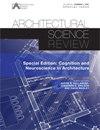热带中庭建筑设计垂直大容量线性槽扩散器的性能评价
IF 1.8
3区 艺术学
0 ARCHITECTURE
引用次数: 1
摘要
本文为热带大型建筑的高效空调提供了一条新的途径。目前的研究有两个目标:一是设计和数值研究垂直定向高容量线性槽扩散器(HCLSD)在中庭建筑中的性能,二是通过实验室规模的实验验证和验证不同的湍流模型。为了深入的性能分析,HCLSD在不同的叶片倾角(φ = 100到250)下进行了研究。通过监测和比较在研究区域内不同位置绘制的垂直线上的速度和温度曲线来评估其性能。通过定量分析,在φ = 0处注意到相对较长的射流抛射。请注意,在这个角度记录了超过33%的面速度增量。在距离扩散器表面8 m处观测到相应的终端速度为0.225 m/s。在0偏转角(case-1)下,对速度、温度场和热舒适指标(PMV和PPD模型)进行了详细的研究。对于被占用区域,热舒适指数在可接受范围内(即PMV = + 0.1至+0.9,PPD = 4%至20%)。缩写:ACMV:空调和机械通风;CFD:计算流体力学;CMH:每小时立方米;DV:置换通风;HCLSD:大容量线性槽扩压器;IAQ:室内空气质量;MV:混合通风;PMV:预测平均投票;PPD:预测不满意百分比;RANS: reynolds - average Navier - Stokes;RNG:再归一化组;SST:剪切应力传递:SIMPLE:压力链接方程的半隐式方法;VAV:可变风量;VSD:变速驱动器本文章由计算机程序翻译,如有差异,请以英文原文为准。
Performance evaluation of an architecturally-designed vertical high capacity linear slot diffuser in a tropical atrium
This paper proposed a new approach for the efficient air conditioning of large tropical buildings. The current study has two objectives: the design and numerical investigations of the performance of vertically oriented high capacity linear slot diffusers (HCLSD) in an atrium building and the verification and validation of the different turbulence models through laboratory-scale experiments. The HCLSD was investigated with varying angles of inclination of the blades (ϕ = 0o to 25o) for the in-depth performance analyses. The performance was evaluated by monitoring and comparing the velocity and temperature profiles along the vertical lines drawn at different locations in the studied domain. A relatively longer jet throw was noticed through quantitative analysis at ϕ = 0o. Note that more than 33% increment in the face velocity was recorded at this angle. The corresponding terminal velocity of 0.225 m/s was observed at 8 m distance from the diffuser face. The detailed investigations at 0o deflector angle (case-1) were carried out for velocity, temperature field, and thermal comfort indices, i.e. PMV and PPD models. For the occupied zone, the thermal comfort indices were found within the acceptable ranges (i.e. PMV = + 0.1 to +0.9 and PPD = 4% to 20%). Abbreviations: ACMV: Air conditioning and mechanical ventilation; CFD: Computational fluid dynamics; CMH: Cubic meter per hour; DV: Displacement ventilation; HCLSD: High capacity linear slot diffuser; IAQ: Indoor air quality; MV: Mixing ventilation; PMV: Predicted mean vote; PPD: Predicted percentage dissatisfied; RANS: Reynolds-Averaged Navier – Stokes; RNG: Re-Normalization Group; SST: Shear-Stress Transport: SIMPLE: Semi-implicit method for pressure linked equations; VAV: Variable air volume; VSD: Variable speed drives
求助全文
通过发布文献求助,成功后即可免费获取论文全文。
去求助
来源期刊

Architectural Science Review
ARCHITECTURE-
CiteScore
4.80
自引率
8.70%
发文量
34
期刊介绍:
Founded at the University of Sydney in 1958 by Professor Henry Cowan to promote continued professional development, Architectural Science Review presents a balanced collection of papers on a wide range of topics. From its first issue over 50 years ago the journal documents the profession’s interest in environmental issues, covering topics such as thermal comfort, lighting, and sustainable architecture, contributing to this extensive field of knowledge by seeking papers from a broad geographical area. The journal is supported by an international editorial advisory board of the leading international academics and its reputation has increased globally with individual and institutional subscribers and contributors from around the world. As a result, Architectural Science Review continues to be recognised as not only one of the first, but the leading journal devoted to architectural science, technology and the built environment. Architectural Science Review publishes original research papers, shorter research notes, and abstracts of PhD dissertations and theses in all areas of architectural science including: -building science and technology -environmental sustainability -structures and materials -audio and acoustics -illumination -thermal systems -building physics -building services -building climatology -building economics -ergonomics -history and theory of architectural science -the social sciences of architecture
 求助内容:
求助内容: 应助结果提醒方式:
应助结果提醒方式:


